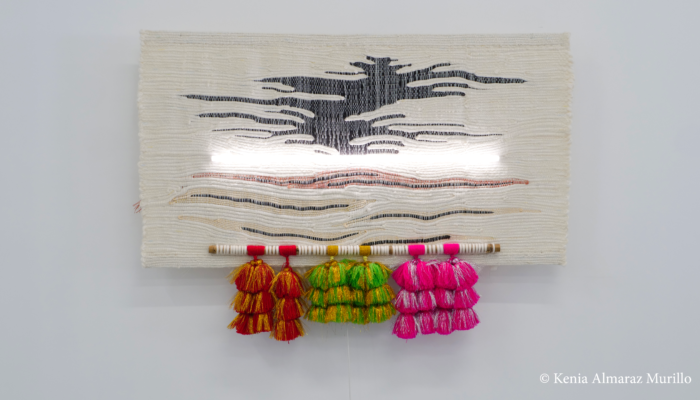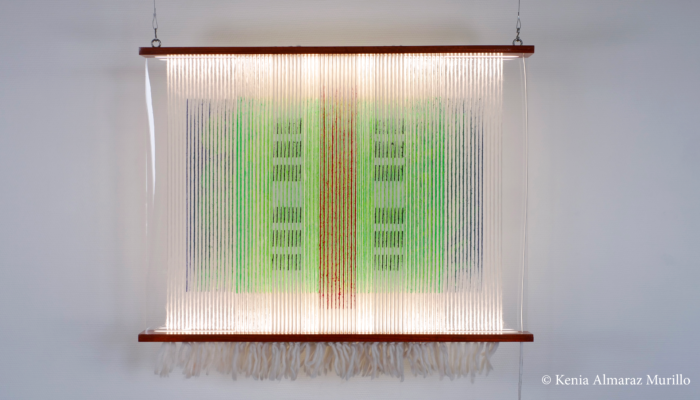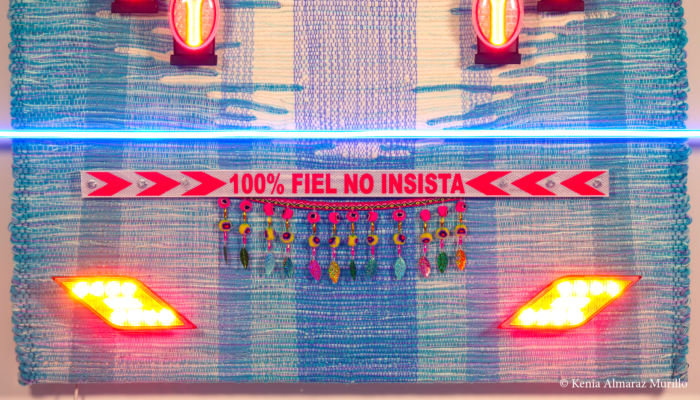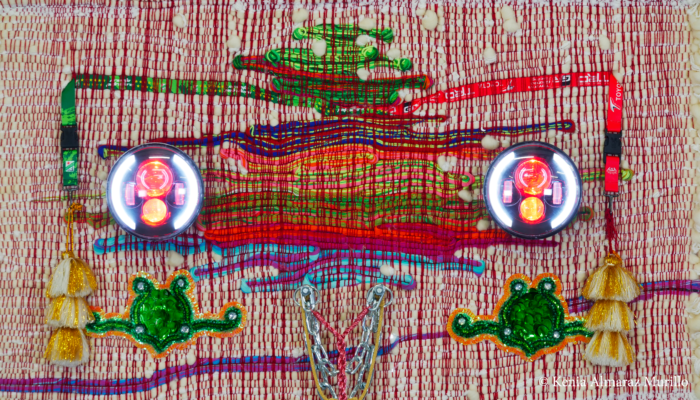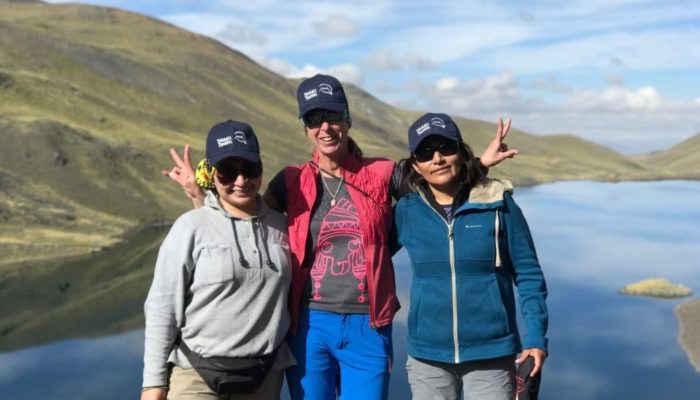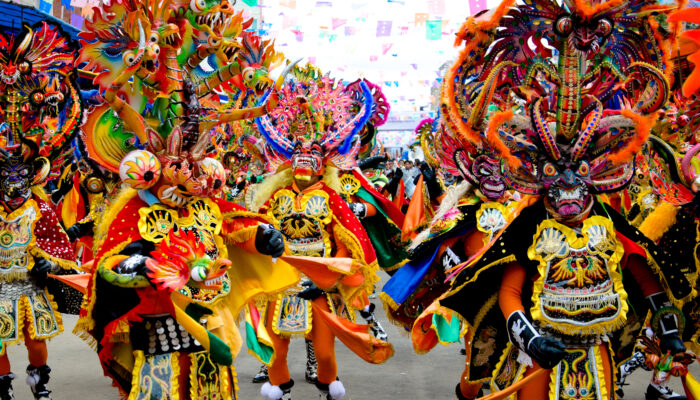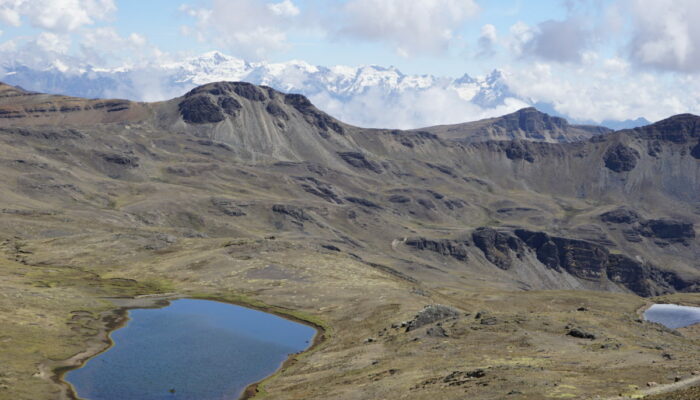Connecting, unifying and merging are the artistic desires of contemporary artist Kenia Almaraz Murillo when she creates.
In a move similar to hers, Thaki Voyage has decided to merge the two subjects of her writings published in March so that they become one in April. Indeed, the articles Tissus et autres tissages, entrecroisez les fils de l’histoire boliviennes and Santa Cruz de la Sierra both echo the work of this young woman of Bolivian origin, born in the same town in 1994.
Between paintings, weavings and installations, this artist, who seeks to strike a balance between the different plastic media, reveals through her compositions the union of elements: the union of thread and light, the union of nature and man, the artist’s personal union with Bolivia and France.
Now living in France for over 15 years, Kenia Almaraz Murillo is steeped in the traditional codes of Bolivian weaving. Her contemporary and philosophical approach is a touching tribute to her native culture. Let’s meet her and capture the essence of Bolivia with her!
A family bond: weaving to write, writing to weave
It was at the age of 16, during a trip to Bolivia, that Kenia Almaraz Murillo discovered the world of weaving and the link between her family and this ancestral art. Her mother showed her some of the aguayos woven by her grandmother. The sight of these traditional Bolivian fabrics gave her a feeling of connection with her deceased relatives, which is why, once back in France, she decided to weave in order to reconnect with them but also with her country and the tradition of Andean weaving.
Weaving in Bolivia is unique, as it has its own language. Our previous article already mentioned this textile universe, where each community has its own weaving, with its own colours, compositions and techniques, including shapes, lines and symmetry. All of these elements are characterised by writing codes, and it is sometimes difficult to decipher each community’s own handwriting.
Today, Kenia Almaraz Murillo communicates her own language when she connects to the threads. She writes a story, her story, the story of her country, using the alpaca or llama wool that is used to make her colourful aguayos.
An act of gratitude: France's encounter with Bolivia's heritage
Although she was deeply influenced by Andean weaving, it was in France that she learnt this technique from the loom of contemporary artist Simone Prouvé.
Before weaving, she was already exploring colours, geometric lines and the horizon through painting, because whether painting or weaving, her works bear a name in the Quechua or Aymara language and refer to Bolivia: landscapes, animals and people are a source of inspiration for the artist. It is precisely the vibrations of these elements that she transcribes in her work.
These vibrations include the energy of the cholitas (represented by natural hair strands and pompoms) and, more generally, living beings. Indeed, Kenia Almaraz Murillo attaches great importance to Pachamama, the Mother Earth that allows us to exist and gives life to a multitude of animal species.
To thank her, she pays tribute to birds, felines and reptiles, but also to the planets and the different worlds. Some of her compositions, created in 2019 after fires in the Bolivian Amazon rainforest, showcase the animals of these areas, such as the armadillo, the toucan and the guajojó. This bird is the source of a popular legend from Santa Cruz, the subject of our next article. Kenia also expresses her interest in Bolivian myths and legendary tales through this volume series, which is not just a work of weaving.
The artist also plays with threads, paint and electricity, as she often chooses to mix what nature provides (such as wood) with what man makes and modifies, by adding artificial light.
The philosophy of balance in weaving light
Urban light complements and adds to the bright colours, precisely the three primary colours, to create balance.
The neon LED or truck headlight light always takes on a different shape: it can be round to recall the planets or stars, straight like the horizon or wavy like a snake or condor. It all depends on the animal or the feeling the artist is experiencing at the time of creation.
The act of weaving is like a meditation for Kenia Almaraz Murillo. It allows her to connect with her dreams and memories. Light, the source of life, merges with energies to form a balance: the plastic balance sought by the artist is the same that harmonises the universe.
Through art, Kenia Almaraz Murillo creates a new energy, both material and spiritual. The creation that results from this encounter brings together unusual materials such as wool and light, and thus connects natural elements with modern, reused or salvaged ones. The artist also finds harmony between the history that unites her with her country and with France: in this way, she eliminates borders.
Weaving makes her travel: she’s “over there in Bolivia but also here in France”, which is why the artist also creates frescoes in her home town, Santa Cruz de la Sierra. When you’re in the area, don’t hesitate to admire the work she created in 2017 in collaboration with Elliott Causse: Flux tressé II.
Kenia Almaraz Murillo has a strong connection with Bolivia. The artist works with traditional weavings that are linked to her native culture in a unique way. Like the Bolivian communities, who write while they weave, she adopts her own contemporary language. Her studio is fascinatingly rich in colour.
You too can feel the energy of this Andean country through the marriage of colour and light, and come and discover the beauty of Bolivia and the balance that exists between Mother Earth and mankind.
Between tradition and innovation, Thaki Voyage shares its love for the Andes and for Art like no one else!
To find out more about the artist: www.keniaalmarazmurillo.com
Thanks to Kenia Almaraz Murillo for the photos.
Text by Mathilde Leroux.

